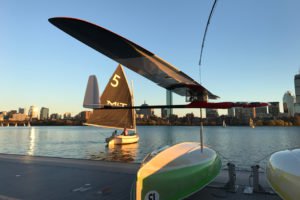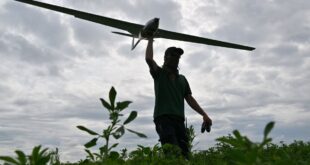MIT engineers have achieved it once more – this time creating an autonomous glider drone that may survey lots of of miles of ocean floor all whereas being powered naturally by the wind.
Created to imitate the albatross, the drone can dip a keel into the water in calm winds to journey like a sailboat – scampering throughout the ocean 10 instances quicker than an common sailboat. When winds decide up, the winged UAV skims the floor of the ocean – all whereas utilizing one-third as a lot wind as its avian counterpart.
Weighing in at a slim six kilos with an virtually 10-foot wingspan, the as-yet unnamed drone design can vary in speeds 5.75 to 23 mph.
The oceans stay vastly undermonitored,” says Gabriel Bousquet, a former postdoc in MIT’s Department of Aeronautics and Astronautics, who led the design of the robotic as a part of his graduate thesis. “In particular, it’s very important to understand the Southern Ocean and how it is interacting with climate change. But it’s very hard to get there. We can now use the energy from the environment in an efficient way to do this long-distance travel, with a system that remains small-scale.”
The journey from fine-feathered observations to a working drone design started because the group created an tutorial paper about albatross flight a few years in the past.
Researchers found that an albatross can execute a maneuver known as “a transfer of momentum, in which it takes momentum from higher, faster layers of air, and by diving down transfers that momentum to lower, slower layers, propelling itself without having to continuously flap its wings.”
Bousquet additionally famous that the hen’s flight propulsion resembles sailboat journey. “Both the albatross and the sailboat transfer momentum in order to keep moving. But in the case of the sailboat, that transfer occurs not between layers of air, but between the air and water.”
The group will quickly current their findings on the IEEE’s International Conference on Robotics and Automation, in Brisbane, Australia.
MIT continues to provide game-changing drone analysis. Recently, researchers developed a VR coaching platform that “fools” drones into “seeing” and flying round digital obstacles regardless of working in an open area. The platform could show helpful within the rising development of FPV drone flight.
Jason is a longstanding contributor to DroneLife with an avid curiosity in all issues tech. He focuses on anti-drone applied sciences and the general public security sector; police, hearth, and search and rescue.
Beginning his profession as a journalist in 1996, Jason has since written and edited 1000’s of participating information articles, weblog posts, press releases and on-line content material. He has received a number of media awards over time and has since expanded his experience into the organizational and academic communications sphere.
In addition to his proficiency within the discipline of enhancing and writing, Jason has additionally taught communications on the college degree and continues to guide seminars and coaching classes within the areas of media relations, enhancing/writing and social media engagement.
Email Jason
TWITTER:@JasonPReagan
 Unmanned Aerial Vehicle The latest drone news
Unmanned Aerial Vehicle The latest drone news



